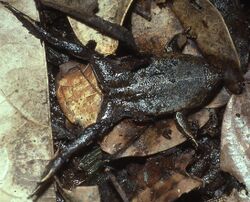Biology:Ctenophryne
| Ctenophryne | |
|---|---|

| |
| Ctenophryne geayi | |
| Scientific classification | |
| Domain: | Eukaryota |
| Kingdom: | Animalia |
| Phylum: | Chordata |
| Class: | Amphibia |
| Order: | Anura |
| Family: | Microhylidae |
| Subfamily: | Gastrophryninae |
| Genus: | Ctenophryne Mocquard, 1904 |
| Type species | |
| Ctenophryne geayi Mocquard, 1904
| |
| Species | |
|
6 species (see text) | |
| Synonyms[1] | |
|
Glossostoma Günther, 1901 — junior homonym of Glossostoma LeConte, 1851 | |
Ctenophryne is a genus of microhylid frogs. They occur in southern Central America (Costa Rica, Panama) and South America. Their common names are egg frogs and Nelson frogs, the latter applying to species in the formerly recognized Nelsonophryne.[1]
Taxonomy and systematics
As of 2017, Ctenophryne includes two other genera, Nelsonophryne and Melanophryne, in synonymy. The latter might represent valid genera, but molecular analyses could not resolve their relationships in a robust way. Placing Nelsonophryne and Melanophryne in the synonymy of Ctenophryne is an interim measure that avoids paraphyly, until new data might resolve the relationships. When Ctenophryne is defined this way, it is a monophyletic group that is the sister group to all other gastrophrynines.[2]
Description
Ctenophryne range from relatively small Ctenophryne barbatula (female size 26–27 mm (1.0–1.1 in) in snout–vent length)[3] to moderately large Ctenophryne aterrima (female size to 67 mm (2.6 in)).[4] The current definition of the genus is essentially based on molecular phylogenetics rather than morphology.[2]
Species
- Ctenophryne aequatorialis (Peracca, 1904)
- Ctenophryne aterrima (Günther, 1901)
- Ctenophryne barbatula (Lehr and Trueb, 2007)
- Ctenophryne carpish (Lehr, Rodriguez, and Córdova, 2002)
- Ctenophryne geayi Mocquard, 1904
- Ctenophryne minor Zweifel and Myers, 1989
References
- ↑ 1.0 1.1 1.2 Frost, Darrel R. (2017). "Ctenophryne Mocquard, 1904". Amphibian Species of the World: an Online Reference. Version 6.0. American Museum of Natural History. http://research.amnh.org/vz/herpetology/amphibia/Amphibia/Anura/Microhylidae/Gastrophryninae/Ctenophryne. Retrieved 8 October 2017.
- ↑ 2.0 2.1 De Sá, R. O.; Streicher, J. W.; Sekonyela, R.; Forlani, M. C.; Loader, S. P.; Greenbaum, E.; Richards, S.; Haddad, C. F. B. (2012). "Molecular phylogeny of microhylid frogs (Anura: Microhylidae) with emphasis on relationships among New World genera". BMC Evolutionary Biology 12 (1): 241. doi:10.1186/1471-2148-12-241. PMID 23228209. Bibcode: 2012BMCEE..12..241D.
- ↑ Lehr, Edgar; Trueb, Linda (2007). "Diversity among New World microhylid frogs (Anura: Microhylidae): morphological and osteological comparisons between Nelsonophryne (Günther 1901) and a new genus from Peru". Zoological Journal of the Linnean Society 149 (4): 583–609. doi:10.1111/j.1096-3642.2007.00270.x.
- ↑ "Nelsonophryne aterrima Gunther 1901". Amphibians of Panama. Smithsonian Tropical Research Institute. http://biogeodb.stri.si.edu/amphibians/en/species/146. Retrieved 8 October 2017.
- ↑ "Microhylidae". AmphibiaWeb: Information on amphibian biology and conservation. [web application]. Berkeley, California: AmphibiaWeb. 2017. http://www.amphibiaweb.org/lists/Microhylidae.shtml. Retrieved 8 October 2017.
Wikidata ☰ Q2587666 entry
 |

